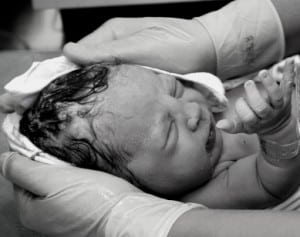
“The birth of a child should be a time of wonder and celebration,” the report reads. “A baby’s first day is the most dangerous day of life – in the United States and countries rich and poor.”
Globally, a million babies die on the same day they are born, the report states. Most of these babies die because they were born too early (35%). Another 23% die because of complications that arise during birth, such as not breathing right away. Another 23% die because of severe infections. Birth defects account for about 9% of deaths. And more than 11,000 of all global deaths occur within the United States.
“The United States has the highest first-day death rate in the industrialized world,” the report said. “An estimated 11,300 newborn babies die each year in the United States on the day they are born. This is 50 percent more first-day deaths than all other industrialized countries combined.”
Throughout other parts of the world, including the countries where most newborn deaths occur (India, where most deaths within the first day occur, Nigeria, Pakistan and China) Save the Children says that most of the deaths can be remedied with simple interventions. In fact, the report says that four products in particular (bag-and-mask devices to help babies breathe, the antiseptic chlorhexidine to prevent umbilical cord infection, antibiotics to treat infection, and steroid injections to delay labor) could save a million newborns each and every year. The cost for these products? Between 13 cents and $6 each.
“Save the Children estimates that, within the first month of life, more than 1 million babies could be saved each year with universal access to these products,” the report said. “Other low-cost interventions such as kangaroo mother care and early and exclusive breastfeeding would save many more babies.”
But what about the United States – a country where access to some of the best medical staff, facilities and equipment in the world is available? Save the Children says in their report that they’re not precisely certain why the United States does so poorly with their newborns, but they say that politics and culture definitely play a part. And they believe that preterm birth rates are a big part of that.
“Many babies in the United States are born too early,” the report said. “The U.S. preterm birth rate (1 in 8 births) is one of the highest in the industrialized world (second only to Cyprus). In fact, 130 countris from all across the world have lower preterm birth rates than the United States.”
Save the Children also says that other factors, like “poverty, racism and stress are likely to be important contributing factors to first-day deaths in the United States and other industrialized countries.”
What’s more, the U.S. has the highest teenage birth rate of all industrialized countries. And since teen births are more likely to result in preterm birth, low birth weight and other complications, it would make sense that this is a big contribution to the high rate of newborn deaths in the United States.
“Teenage mothers in the U.S. tend to be poorer, less educated, and receive less prenatal care than older mothers. Because of these challenges, babies born to teen mothers are more likely to be low birth weight and be born prematurely and to die in their first month. They are also more likely to suffer chronic medical conditions, do poorly in school, and give birth during their teen years (continuing the cycle of teen pregnancy),” the report said.
But other potential causes are a little more obscure, or harder to support in theory. For example, half of all pregnancies in the United States are unplanned. Women with such pregnancies are less likely to take care of themselves or receive prenatal care to protect their unborn children, Save the Children says. Additionally, health care in the United States is severely lacking, which could further compound the issue of lacking health care prior to, during and after pregnancy.
“High-quality care before, during and after pregnancy (including home visits by nurses or community health workers, if appropriate) and access to the appropriate level of care at the time of delivery can result in healthier mothers giving birth to healthier babies,” the reports said.
Such visits and care are very common in countries like Europe. But they are extremely rare in the United States, as is health care prior to pregnancy unless you can afford health insurance or are low-income enough to meet the criteria for state-funded insurance (which is very difficult to do unless you are already pregnant).
Save the Children also linked politics – another interesting but obscure cause – to the high rate of newborn deaths in the United States.
“Women hold only 18 percent of seats in the United States Congress,” the report said. “Sixteen countries have more than double this percentage of seats occupied by women. In Finland and Sweden, for example, women hold 43 and 45 percent of parliamentary seats, respectively.”
And interestingly enough, Finland and Sweden are the two countries with the lowest rate of newborn deaths in the world. Is it possible that the answer could be just that simple? That, by placing more women in the seat of authority, we could decrease the rate of newborn deaths in this country? It’s a possibility, but that would mean taking care of yet another possible cause of newborn deaths – lack of education, which Save the Children calls key to improving infant death rates because it is the only factor that ties in to all of the other potential causes.
“The more time girls spend in school, the later they marry and begin childbearing,” the report said. “Educated girls are also more likely to grow up to be mothers who are healthy, well-nourished, economically empowered and resourceful when it comes to caring for themselves and their babies.”
One success story that seems to back up their theory is Bangladesh – a country that managed to reduce its infant mortality rate by 49 percent since 1990.
“Increased family incomes, lower fertility rates and higher levels of female education likely account for the significant share of this success,” the report said. They added that door-to-door health workers have also made an impact.
What are your thoughts on how the United States could turn their newborn mortality rate around?
Related Articles:
- Neighborhood Demographics may Effect a Child’s Risk of Obesity
- Empty Gas Tank Forces Dad To Deliver Baby in Sam’s Club Parking Lot!
- Extremes in Fetal Growth Rate Result in Higher Risk for Autism, Study Says






